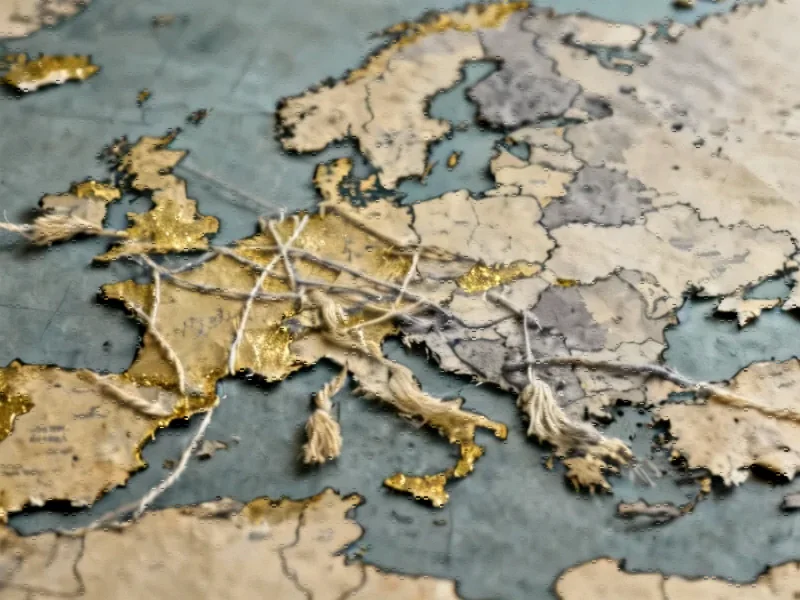The Political Calculus Behind EU’s Ukraine Loan Strategy
As European Union leaders convene to discuss a groundbreaking €140 billion “reparation loan” for Ukraine, the complex financial engineering reveals deeper political tensions than initially apparent. While publicly framed as making Russia pay for its destruction in Ukraine through frozen assets, the actual mechanism carefully avoids touching Moscow’s legal claims to these funds. Instead, the EU plans to strong-arm Euroclear—the Belgian securities depository holding most Russian hard-currency reserves—to lend cash accumulated from matured Russian investments, with Brussels providing IOUs backed by member states.
The German Chancellor’s recent endorsement has given this long-pushed European Commission plan crucial momentum, yet the contradictions within the approach deserve scrutiny. As European financial authorities consider this unprecedented move, they’re navigating both political signaling and practical constraints that may have far-reaching consequences for European security architecture.
The Burden-Shifting Mechanism
At its core, the proposal represents a sophisticated burden-shifting exercise rather than genuine asset confiscation. Ukraine would receive substantial funding, but repayment would depend entirely on future Russian reparations—creating a scenario where European taxpayers ultimately bear the risk if Moscow never pays. The EU would never default on its obligations to Euroclear, meaning the financial exposure remains within the bloc regardless of geopolitical outcomes.
This approach contrasts with more direct methods like issuing bonds, which the EU already employs for various purposes including Ukrainian support. The accounting advantages appear minimal beyond potentially saving some interest by forcing custodians to lend at zero rates—savings that were already being captured through previously agreed special levies.
Political Signaling and Its Contradictions
The political rationale reveals a dispiriting reality: EU leaders, particularly Germany’s chancellor, want to demonstrate long-term commitment to Ukraine while simultaneously revealing Europe’s growing financial constraints. This dual messaging creates conflicting signals to Moscow—showing determination while exposing fiscal limitations. The approach also represents what might be a one-time trick, as €140 billion, while substantial, represents less than two years of total support at current spending levels documented by the Kiel Institute.
Meanwhile, global security concerns continue evolving in parallel with these financial maneuvers, creating a complex international landscape where economic and technological threats increasingly intersect.
Control Versus Sovereignty Questions
Another tension emerges regarding control over the funds. While German leadership insists the money should be used exclusively for weapons, this condition raises sovereignty questions. If the loan truly represents an advance on reparations owed to Ukraine by Russia, the logical position would grant Kyiv discretion over allocation. This control dynamic reflects broader industry developments in international finance where donor conditions increasingly shape recipient priorities.
Alternative Approaches and Future Implications
Superior mechanisms exist that could achieve the same objectives without European taxpayer exposure. As some experts have advocated, the EU could employ prudential bank regulation to isolate Russia-related assets and liabilities into a separate “bad bank” entity. This could then be purchased by a coalition of willing governments and relocated to a jurisdiction with greater legal flexibility than Belgium, enabling genuine reparation loans without EU financial exposure.
The current proposal, if implemented, may subtly transform the politics surrounding frozen assets. European public finances would become directly tied to Russian reparations and sanctions policy, potentially stiffening resolve in countries like Germany where influential voices have privately dismissed reparations as part of any final settlement with Russia. This financial entanglement could make it harder for external actors—including a potential Putin-Trump alliance—to take European acquiescence for granted.
As related innovations in financial technology continue emerging, the mechanisms for managing frozen assets may become more sophisticated. The current approach represents an important test case for how democratic nations can leverage economic statecraft in conflict situations while navigating complex legal and ethical boundaries.
Despite its flaws, the plan’s supporters rightly note that getting substantial funding to Kyiv remains paramount—without which Ukraine faces military defeat and Europe confronts a devastating security crisis. The urgency of preventing this outcome justifies imperfect mechanisms, though the financial engineering involved in major project financing demonstrates how complex these arrangements have become in contemporary geopolitics.
By raising the direct financial cost of its traditional caution, Europe may ultimately secure greater influence in shaping Ukraine’s future and the broader European security order. The frozen assets debate thus represents not just a financial question but a fundamental test of European strategic autonomy in an increasingly contested international system.
This article aggregates information from publicly available sources. All trademarks and copyrights belong to their respective owners.
Note: Featured image is for illustrative purposes only and does not represent any specific product, service, or entity mentioned in this article.



